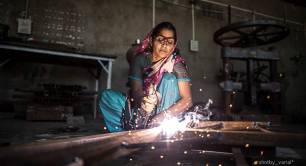Where are all the women in social investment?
As a child one of my favourite books was the Wild Washerwomen – a story of a group of women who rise up against their employer and go on the rampage through the local countryside. As I began my career, I never thought this would be something I would come to reflect on.
In the charity sector where I started out, there are many brilliant role models leading inspirational organisations who I could aspire to follow, despite there not being enough women at the top (they make up two thirds of the workforce but represent only a third of CEOs).
At the beginning of 2016 the Social Investment Business announced that Hazel Blears would be its new Chair. Hurrah, I thought (quietly, so as to not denigrate my fantastic male colleagues). Finally some great women arriving at the top of social investment organisations.
But this cheer was rapidly replaced by despondency at the fact that the arrival of one woman was so noticeable. And that little more has changed since. Sure enough the numbers back this up.
A quick (and entirely unscientific) review of the websites of thirty social investment organisations revealed that while half of those working in social investment are women, this reduces to a third in senior teams, and 7% at CEO level. That’s just two women CEOs. Similarly women make up 29% of those at board level, but only two organisations have a female Chair, including Hazel.
These numbers will come as no surprise to anyone working in this sector – or to anyone who has ever seen a panel discussion of senior figures from social investment. But just because it’s not surprising, doesn’t mean we shouldn’t be shocked – and compelled to do something about it.
So why does it matter? Well first and foremost, social investment is in the business of social justice and positive social change, so we should know that gender equality matters. It is a core foundation for tackling poverty, reducing violence and improving education, to name just a few reasons. We must be committed to gender equality in all areas of life.
Secondly, one of the most exciting things about social investment is that we are a relatively new sector, modelling new ways of doing things. But why are we just innovating with finance? We don’t have gender legacy issues from archaic organisations. We have the chance to model a new way of doing things within our organisations too, and we should.
To get to some of the business arguments, what is the risk for talent retention if half of the workforce can’t see realistic leadership opportunities for themselves? And what a risk for decision making if we don’t have diversity amongst the people making decisions – and here I must add that someone also needs to look with scrutiny at other areas of diversity, such as ethnicity and age.
One of the wonderful things about working in social investment is that everyone I work alongside is driven by strong social values. So I find it hard to believe that there would be anyone in this sector who wouldn't be convinced by at least some of the arguments above.
So what do we all need to do? We can start by asking whether we know what the ratios look like in our own organisations and whether, with hindsight, there are things we could have done differently to improve those statistics. And then we should do those things.
If we’re recruiting externally we should refuse to continue a recruitment process where there is an all-male shortlist. This is exactly where those 29% of female board members can really make a difference. Or if we’re keen to develop talent within our organisations, senior male leaders could provide more opportunities for their female deputies to attend high-level meetings on their behalf to widen their experience.
In short, it’s not rocket science. But we must decide that this matters, and commit to do something about it. Otherwise we will never deliver our most ambitious vision for social change. And we might just end up needing to go on the rampage.
 This article was first published in Pioneers Post Quarterly Issue 5. Read the rest of this issue here. It has been written in a personal capacity and does not necessarily reflect the views of Big Society Capital.
This article was first published in Pioneers Post Quarterly Issue 5. Read the rest of this issue here. It has been written in a personal capacity and does not necessarily reflect the views of Big Society Capital.
Photo credit: Picjumbo



